Tips for Quality Run Training Train no faster than one pace quicker than the race you are training for. For example, 5k pace is good for an Olympic-distance race, while half-marathon pace suffices...
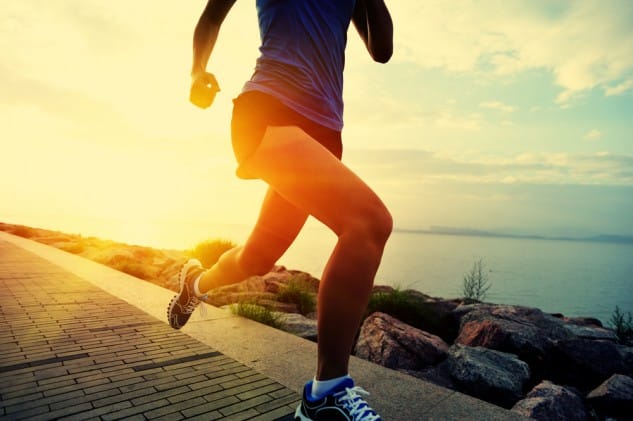

Tips for Quality Run Training Train no faster than one pace quicker than the race you are training for. For example, 5k pace is good for an Olympic-distance race, while half-marathon pace suffices...
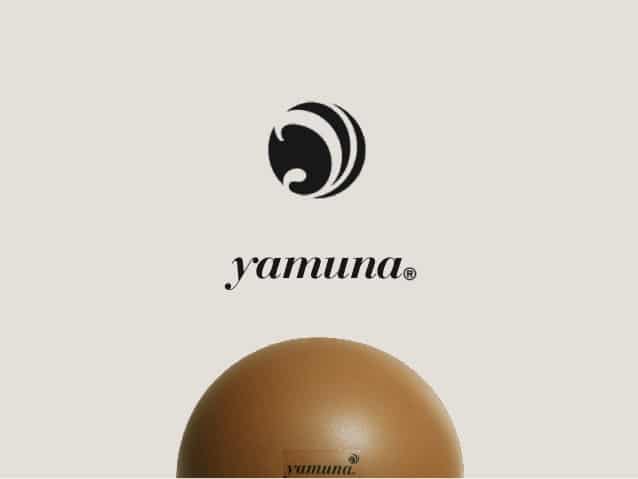
Being immersed in the fitness industry provides me with a ton of different opportunities to experience different techniques, methodologies, and products. I recently had the privilege of a...
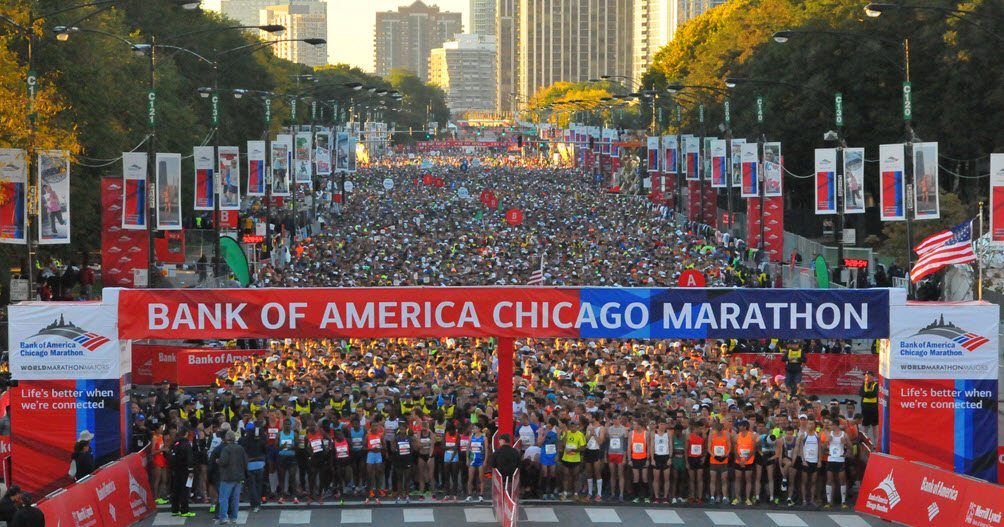
Leading up to the Chicago Marathon 2016 The Chicago Marathon provides an excellent course, plenty of support and, for me, a chance to visit home for a few days. It was no different for me this...

September 25 was going to be my day. The Ironman Augusta 70.3 triathlon was finally here. The race I had been training so hard for on one of my favorite courses. It was four-and-a-half months...
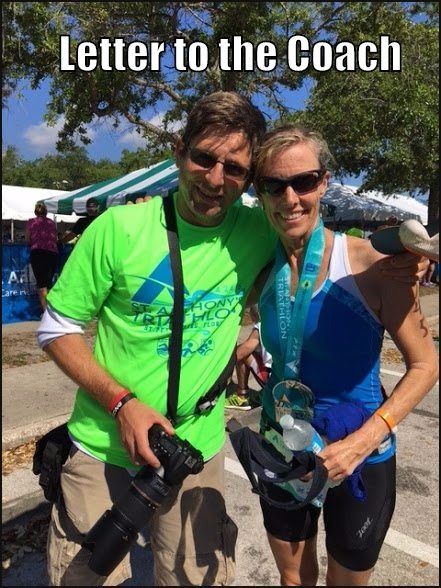
I have been an endurance coach for some time now. Once in a while, I receive an email from a client which chokes me up with pride. Today, I received one of those letters, so instead of sharing it...
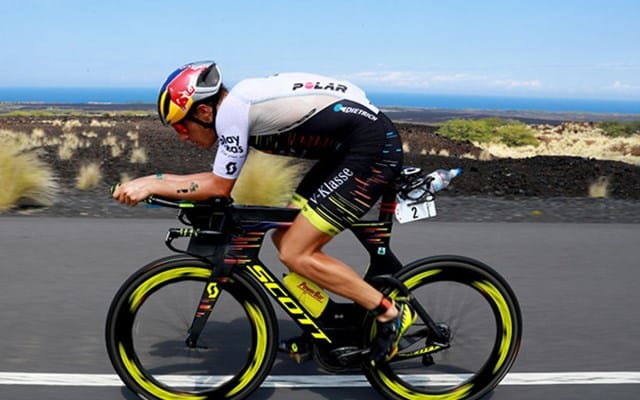
I found when looking for ways to get faster on the bike, is that there is so much information, from different coaches and experts, that it can be confusing and overwhelming. Personally, I...

I personally have been involved with charities that specifically relate to Cancer for over a decade now. With that in mind and the fact the my friend Ben Mena has taken on a challenge with the The Little Things for Cancer and created a team to run the Marine Corps Marathon, I thought this would be an appropriate time to incorporate a guest post by my friend David Haas. His bio is at the bottom of the post, but he is very active in creating awareness and outreach for Mesothelioma. Enjoy this great article and pass it on to anyone you know that cane be of benefit. Carpe Viam!
Nutrition plays an important role in helping to prevent many types of cancers, but it also plays a major role for those going through cancer treatments and therapies. Eating the right foods can help you maintain your energy levels, gain needed strength to go through treatment and improve your quality of life. However, vicious side effects such as nausea, loss of appetite and extreme fatigue can seriously affect your ability to eat.
Learning how to side step these problems and improve your nutrition can make cancer treatments easier to handle.
Nausea
Common cancer therapies such as surgery, radiation or chemotherapy often result in nausea. Since weight loss can lower immune system function, sap your strength, and lower your vitality, it’s particularly important to learn how to improve your nutritional condition when nauseated.
Start by eating smaller meals more frequently throughout the day. Sipping carbonated beverages, using foods or drinks that contain ginger; sipping clear soups and avoiding spicy foods can also help. It’s also important to stay hydrated, so focus on foods that contain plenty of liquids such as puddings, custards and creamy soups.
Loss of Appetite
The stress and emotional upheaval that comes with a cancer diagnosis can seriously affect your desire to eat. Uncertainty, fear of the unknown and strained family relationships only adds to the burden. Even if you don’t feel hungry, it’s important to eat a balanced diet that’s high in protein, fruits and vegetables. The University of Arizona Cancer Center suggests you take advantage of the time of day when your appetite is best.
Focusing on higher calorie foods for both meals and snacks will help because you won’t need to eat as much volume. Try adding fortified protein powders to milkshakes, snack on cheese and nuts, and add sauces or extra fats to your vegetables. Making sure you exercise everyday can also help to increase your appetite.
Fatigue
When you’re tied and worn out due to anxiety, medication, or treatment, poor nutritional practices only makes the depression or dragged out feeling worse. Getting plenty of liquids, exercise, and nutrient-dense foods in the form of colorful fruits and vegetables are important to keep the fatigue from getting you down.
While some causes of fatigue from cancers can’t be avoided, like the symptoms of mesothelioma, make sure you’re eating plenty of iron-rich whole-grain cereals, getting adequate sleep and eating enough protein foods such as eggs, beans and dairy. While paying attention to nutritional details can feel like it’s more trouble than it’s worth, keeping your nutritional intake high during cancer treatments can give you that extra edge you need to survive.
David Haas
Joining the MCA in 2011, David Haas is the Director of Awareness Programs. In addition to researching much of the information available to our site’s visitors, David often blogs about programs available and campaigns underway at the Mesothelioma Cancer Alliance. David is a fitness enthusiast who frequently runs, climbs, and bikes for enjoyment. He is also very involved in outreach associated with awareness about the dangers of asbestos for many different organizations and groups of people.
to researching much of the information available to our site’s visitors, David often blogs about programs available and campaigns underway at the Mesothelioma Cancer Alliance. David is a fitness enthusiast who frequently runs, climbs, and bikes for enjoyment. He is also very involved in outreach associated with awareness about the dangers of asbestos for many different organizations and groups of people.
Read more: http://www.mesothelioma.

One of the scariest things for a beginning triathlete, besides getting in the open water, is cycling. The first image that wandered into my head upon deciding to start seriously bicycling was of a that scary peloton. Those tight formations of bikes moving at ridiculous speeds, during the Tour de France, so close together that one wrong move could cause serious damage to my body or someone else. Scary right? Luckily, triathlon doesn’t allow for huge groups like that, as a matter of fact it isn’t even allowed. Whew!
Buying my first Bike
I didn’t have a lot of money when I first started in triathlon, and I also didn’t really know if I was going to like it. I spent a lot of time in bike stores drooling over the expensive bikes, while studying cheaper entry level bikes. Every bike store had a different angle they played. One would say, purchase the more expensive bike, gain more speed so when I improved I didn’t have to buy another bike. Another would tell me to buy the entry level but load it up with expensive components so I could ride faster, and when I wanted another bike, the components alone would warrant a good price, and of course that store would buy it back from me and give me a discount an another bike. Decisions, decisions what to do, what to do?
I researched different road and tri bikes online and in magazines, and while I was pretty sure I would enjoy triathlon, I decided on an entry level Canondale CAAD 9 road bike. I also included in my purchase, a pair of pedals, cleats, shoes and a helmet. The helmet was very important especially since I hadn’t actually rode a bike in over 10 years. Would I really not forget how to ride a bike? The answer to that my friends is YES. It is not a skill that is forgotten. It maybe a little unsteady the first couple of times, but not forgotten. Luckily I will have my trusty helmet, just in case.
I would enjoy triathlon, I decided on an entry level Canondale CAAD 9 road bike. I also included in my purchase, a pair of pedals, cleats, shoes and a helmet. The helmet was very important especially since I hadn’t actually rode a bike in over 10 years. Would I really not forget how to ride a bike? The answer to that my friends is YES. It is not a skill that is forgotten. It maybe a little unsteady the first couple of times, but not forgotten. Luckily I will have my trusty helmet, just in case.
I also read something that resonated with me. The most important thing that is needed after the purchase of a bike, is the fitting. At first I thought, “what? Don’t I just have to find the most comfortable height of the seat and then get going?” I had no idea that there are so many different adjustments on a bike, to a point that bike “fitters” actually have to be certified in order to properly fit you. They have to take courses, pass tests and be mentored. “Really?”, you ask? Yes…really.
The fitting took about an hour where they put my bike on a trainer, and with my shoes and bike shorts I pedaled, then the fitter took measurements and made adjustments to my seat post raising it and lowering it to a perfect dimension. Then he took angle measurements from the ground to my hip, knee and shoulder and from the pedal and a bunch of other places. He moved my saddle not only up and down by forward and back. He then took my handle bars and put different size spacers on the tube underneath my handlebars to find the perfect height and then was able to move them back and forth to find the right angle, height and most comfortable spot for me. I had no clue there was this much to it.
Pre-First Ride
As I left the store after my fitting, Jo-el, the general manager and friend from my track club, gave me some good advice. I had never rode in cleats and pedals before, where my feet were clipped into the pedals where they wouldn’t just simply lift up. I had to turn my heel so the cleat would unclip from the pedals so I could put my foot down. Jo-el said to take my bike in the house and put it between a doorway, and practice clipping and un-clipping from the pedals. Also, I needed to find the most comfortable side to unclip first and then stick to that side no matter what. I followed that advice in detail. I clipped, unclipped, clipped and unclipped till I was sure I had mastered it. Then I took a little ride around the block and practiced even more till I was confident I mastered at least that part.
I had a feeling of euphoria that first little trip in my neighborhood. I felt fast, free traveling under my own power on this brand new, tuned Cannondale bike. I was really excited for my first ride the next day in the hills of San Antonio.
The First Ride
I drove to San Antonio…Florida that is, with my brand new bike in the back, my new bike shorts on, bottles ready to put in their cages on the bike, coffee in my cup holder and classic rock playing on the radio. I remember having mixed feelings about this initial ride. I had never ridden in a group before, I had never ridden with these cleats and clips before, but I knew I was in good shape but was I fit enough? After that I just thought to myself, “if you cannot go as far then just turn around and head back. no big deal.”.
I met a friend at these ball fields and was mesmerized by the amount of bikers getting ready to take their morning ride. The sea of colors from the different bikes and jerseys was extremely overwhelming. That anxious feeling came back for a second until my friend mentioned we were riding with triathletes not pure cyclists. They would understand I was on my first ride and would help me out. After preparing for my first journey, we found our formation and began the trek.
I was surprised that I was staying in the middle of the pack and with minimal effort. The wind was in my face, I was pedaling under my own power and keeping up! It was an incredibly euphoric feeling. Unfortunately, when we hit the first long hill, euphoria turned to anxiety and then… embarrassment.
My pedaling slowed, and it became extremely hard to mash down on the pedals. With very minimal spinning of my legs I tried to switch to higher gear, but I actually ended up in a lower gear which made it even harder. When I did finally gear up, it was too late. I couldn’t move the pedals fast enough to switch gears, and my chain fell off , so I was at a dead stop. Of course I was so concerned about the gears I didn’t unclip out of my pedals, and I went down on my side. The only thing that really hurt was my ego as I stood my bike up and examined the chain. The group was passing me all asking if I was ok, and taking for granted that I was telling them I was fine and to keep going. By the time I had my chain back on the group was completely out of site. I pedaled like a bat out of hell hoping to catch up, but I missed a turn and ended up 10 miles out of my way, and lost.
To make a long story short ( I know, too late) one of the faster members of the group realized I was gone, backtracked, and finally found me asking directions at a convenience store. He led me back to the group and I finished the ride without any other issues, but I learned a lot of lessons that day.
Hints to get started in cycling straight from the Goof:
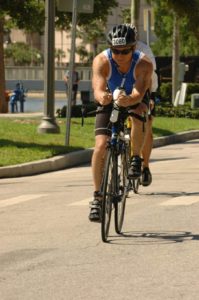
On my first bike after a couple of modifications
1. Buy an entry level road bike. This is usually an aluminum alloy frame. You don’t want a Wal-mart special, but you don’t need to start with the top of the line bike either.
2. Purchase a set of entry level pedals, cleats and shoes. The pedals usually come with the cleats and the bike shop will install them for you.
3. Purchase safety equipment. Biking shorts, and a helmet to start. I would also have a set of sunglasses as well. Not just to keep the sun out of your eyes, but it helps with the wind too. Make sure you also have at least one water bottle with a cage installed on your bike.
4. Get the bike fit for you. Have a certified bike fitter make those adjustments specifically for you.
5. Practice getting in and out of your cleats . Put your bike in a doorway, hold onto the frame and get in and get out of your cleats. Find the most comfortable side of the bike and then practice getting out of the cleats and putting your foot on the ground.
6. Take a short ride around your neighborhood and continue to practice getting in and out of your cleats. When seeing a stop or even a potential stop ahead practice just moving your heel just to the point where you unclip before stopping so you have a quick option that you can pull out of your clip to stop or return your heel to clip back in to keep going. Remember to always clip out and stand with the same foot first every time.
7. Understand your gears. While in that first ride, switch the gears on your right hand and find what lever takes you to a higher or easier gear, and which one brings you to a lower or harder gear.
8. Take your first long ride with friends and have some fun.
One last thing, you are going to fall. That is just the reality of it. You will get stuck in your cleats at some point and you will fall over, but it will be minimal. The trick is to accept it, get up brush yourself off, laugh at yourself, get back on your bike and have fun. It’s worth it I promise.
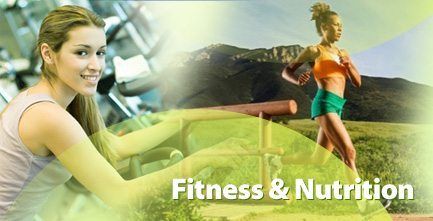
~This is a guest post by a friend of mine, Dr. Karen Danish, LAP ~Enjoy!~
It’s difficult to talk about nutrition without fitness, and fitness without nutrition. They go hand-in-hand, and help balance each other out, creating a healthy body and mind. Proper nutrition fuels the muscles to help us power through not only tough workouts but our day-to-day activities. Nutrition, by definition, is a process the body uses to digest food and use it for energy, growth and development. Fitness describes our body’s ability to process energy in the most efficient way possible. It covers a wide range of topics including endurance, body composition, strength and flexibility. Without proper nutrition, our bodies have the inability to work on fitness levels. See? You just can’t talk about one without the other. Here, we’ll talk a little bit more about how nutrition helps your fitness, how a lack of nutrition hurts it, and why exercise alone isn’t enough.
Have you ever heard, “You are what you eat?” It’s true, especially when discussing nutrition and fitness. And it’s pretty simple. Eating bad food makes you feel bad, and eating lots of good food makes you feel really good. Foods that are packed with vitamins, nutrients and are more natural are better for you and your body. Higher calorie, processed foods take a toll on your body and daily routine. Foods higher in nutrients give you energy, keep you focused on work or chores, and a healthy diet can promote good health habits in all areas of your life. When you eat right, your body works more efficiently, giving you the energy to exercise and keep up your fitness routine.
You know that good foods make you feel and look good, so why do bad foods hurt your fitness? Things on the outside might look ok with a poor diet, but on the inside, blood sugar levels are adversely affected, cholesterol levels can skyrocket, major damage can be done to the heart, and your digestive tract will not work as efficiently. Your motivation to keep up a healthy exercise routine will take a hit as well. You won’t have enough energy to make it a priority. It’s just a fact: you cannot out-exercise a bad diet.
Many people think that even if we don’t maintain a perfect – or even great – diet, we can hit the gym and still maintain a healthy body. This is not only wrong, but dangerous. If you load up on unhealthy, sugar-laden foods then head to the gym for an intense workout, it spells trouble. Eating foods that are packed with nutrients are better for powering a workout and helping you sustain your fitness level. The wrong kind of fuel will cause an inevitable breakdown at some point. Your body needs and deserves the right kind of energy, which is important to an active lifestyle.
It’s simple: nutrition and fitness go together. Always. Your body needs a healthy diet in order for it to what you want it to do efficiently. Consult a doctor or dietitian with specific questions about what you should be taking in to support your fitness routine.

This post was written for IronGoof, by Karen Danish, LAP. Karen is a licensed acupuncture physician and a valued staff member at Anne Hermann MD, PA, St. Petersburg Weight Loss Clinic.

HITS is a fairly new triathlon series, with a unique concept. Their tag line is “A distance for everyone”, which really says it all. A HITS weekend consists of 70.3 (half-iron distance) and a 140.6(full-iron distance) on Saturday, and on Sunday, Sprint and Olympic distance triathlons. It is a pretty cool concept, and they are really well-organized.
After having breakfast with the Team Foley after the Fight for Air Climb I headed out to Ocala with the hope of seeing at least Margie, Kari and Megan cross the finish line. I have to admit, while I have been training, it hasn’t been as focused as it should have. My “off-season” mentality didn’t quite transition into the race attitude just yet, but I thought I was at least in shape to do the Oly. In triathlon season, usually the first couple of months, is usually “Base” phase which just gets the wheels and legs rolling again, develop some strength and start gaining the endurance needed for race season. With that in mind, I figured an Olympic distance would be perfect to baseline where I am in my training. Imagine my surprise when I saw a lot of my friends out on Saturday competing in the 70.3. As I was watching competitors and friends cross the line there was a familiar itch developing in my heart. I didn’t quite notice what it was at the time.
The course for the 70.3 was pretty intense with loops that included a 1.2 mile swim in a 65 degree Lake Weir, 56 miles of rolling hills and wind of the bike, and an intense mixture of soft trails, and asphalt out-and-backs for the 13.1 mile run. I was too busy losing my lungs to catch any of the swim or bike, but I was happy to be around to see the finale of the run.
I had my first blog recognition, which was really nice. I was at the expo, grabbing a couple of Honey Stinger gels for my race the next day and I was chatting with the owner of Kickstart Endurance and she told me she followed IronGoof. I tried not to make a big deal out of it, but secretly I was really excited.
I missed Margie, but I was really happy to see Megan and Kari cross the finish. They both were finishing their first 70.3 along with some other members of the Tri Psych Club, so for them this was a huge accomplishment and deserved a celebration. That itch started to intensify at Chili’s that night as everyone’s conversation about their race surrounded me.
I really attempted to be nonchalant about this race. I kept telling myself, “Self, this is no big deal. You know you are not ready to race, this is a small race and this is going to tell you what you need to work on.” Unfortunately, waking up the next morning at 4:30a, and preparing my gear not only woke up my consciousness but the competition juices and anxiety levels as well. I showered, dressed, applied my TriTats, loaded the car and off I went.
As I mentioned before, the organization of this race was first-rate, from, staff organizing parking to the transition areas. Have I mentioned the transition area? In previous races I have barely glanced over the amenities of the transition areas, well except for the Rev3 Venice Beach. Let me put it this way, if the transition areas were cars, then every other race I have been in were Toyotas, the Rev3 was a Lexus, and the HITS series was a Bentley. Not only were there boxes that held gear and clamped a tire for easy removal of the bike, plenty of room for transition setup in-between the bikes, but each participant had their own personal stool with their number and last name on them. It doesn’t sound like a lot, but it really is the little things that make an impression.
I headed down to the beach with my wet suit on halfway, goggles and swim cap in hand. The temperature outside was perfect with just a slight breeze and the sun was starting to slowly creep up over the horizon. I was incredibly grateful to see my friends down on the beach. Pete, Kari, Megan, Michael, Stan and a couple f others as it made me feel slightly less stressed. After the mandatory meeting, all of the males waded out a bit into the water for the start. My anxiety reared a little due to the fact, I was using my backup goggles because my regular goggles broke in transition and this was the coldest water I had ever swam in.
The whole beach counted off, “Three, Two, One…” and the horn blew. We all ran or dolphin dived toward the first buoy. The water was kind of shallow so I did have some time to start to get used to the water. I remembered my strategy and my stroke count and I started swimming. I started losing ground within the first 200m, which was normal for me. My new stroke technique is still relatively new, so I figured I wasn’t going to be fast immediately. When I reached the first buoy, I started feeling short of breath, even though I thought I was relatively relaxed. My chest started to feel compressed like I was being stepped on, and my arms were not moving as freely as I wanted them to. I moved to breast stoke to see if I could relax a bit, but it was to know avail, the compression would just not loosen. I have never had an issue with my wet suit. Except for getting out of it, I kinda like it. I feel more buoyant, warmer and protected from other things that may cause issues in open water. Now I just felt like it was python, strangling me. I kept going, but it was a combination of freestyle, side stroke, and breast stoke. When I reached the second buoy, my mind went into overdrive trying to get me to quit. The ideas popping in my head were asinine. I kept hearing, “You aren’t trained for this”, “You don’t belong here.”, “Just get out of the water. It is only a baseline remember?”. The thing was, I had another loop to do. I swam toward third buoy, and the water became very shallow, so we really didn’t have any choice but to run through it and start dolphin diving again. I forced myself to have the one thought that has gotten me through tough training, cold, wet and rainy workouts, and exhausting races; “The mind will quit one-hundred times before the body does.” I told myself, “Self, that is first and only time that is going to happen today.” I ran around the third buoy and headed out for my second loop.
The second loop felt a little better, but I was so happy to get out of that wet suit. I am still not quite certain why I felt that way. It wasn’t the size of the wet suit because when I bought it I was 25 pounds heavier. Either way I ran out of the water unzipping and getting out of it on my way to transition. One of the strippers told me to lay down and she yanked it off of me. I grabbed my helmet while I put on my shoes and crossed the mat in less than 3 minutes.
The bike course was actually pretty nice. Rolling hills, with well conditioned roads and plenty help by the Sheriff’s department. I wanted to make up sometime, so in my head I thought to just keep passing people. I only got passed twice during the first ten miles of the twenty-five mile course and I was happy with that. I played cat & mouse with a couple of them, and ended up passing them in during the last half of the course. Unfortunately, there was a storm on the horizon and the wind picked up quite a bit on on the second half, not to mention the hills were more abundant and steeper(at least for Florida). My speed, that I was holding quite consistent at 21 mph started to drop to 18, then 17 and at that point, I refused to go under 18 mph. I came into transition, averaging 19.1 and I was proud of that.
I racked my bike and sat on my stool to put on my socks and shoes. I got hung up a little bit, but was still out of there in less than 3 minutes, and it was off to the run. Pete yelled at me as I headed into the trees, “This is the fun part”. At first I agreed with him.
I decided to wear my Hoka One One Biondi Speed 2 running shoes with the large sole, because I wanted to test how they felt on a triathlon after being on the bike. Big mistake. At first the ground wasn’t very soft, and I was ok running about an 8:15 mile, but as I got further into the woods, the trail got softer and softer. With that big sole, not only was my foot pushing down on the sole, but then into the soft ground causing three times as much resistance as the a regular running shoe. I didn’t figure this out at first, but after one-and-a-half miles, I felt like I needed to stop, and that was not usual, not matter what kind of shape I was in. I walked at the aid station for about 200 yards and then I continued running but at a much slower pace. I had to do two loops of the run course as well, and I could feel the resistance ease off when I hit the asphalt again. All of the sudden I was lighter and faster, but I had to do a second loop into the woods again. I decided my strategy would be to walk a hundred yards at the aid station and 100 yards at the turn-around, but other than that I would let my legs do what could. It worked out well as my splits were faster on the second loop.
I ran out of the woods with Pete snapping shots and hearing cheers from Megan, Kari and a couple of others. As, I  crossed the finish line it became clear to me, that I am not in the shape I was in for my last 70.3, but I would enjoy this moment as a victory. It was not a PR, but it this race let me know what I need to do over the next months in order to take on the rest of my race schedule.
crossed the finish line it became clear to me, that I am not in the shape I was in for my last 70.3, but I would enjoy this moment as a victory. It was not a PR, but it this race let me know what I need to do over the next months in order to take on the rest of my race schedule.
After calming down a bit and chatting with Pete and a few other friends, Summer Bailey found me. She had competed in the 70.3 the day before. Summer lives in Georgia, so we really only see each other at races and occasionally chat on Facebook so it was really incredible to actually chat and catch up with her in person. She is an amazing woman and with a huge heart and ferocious determination. We both agreed that neither one of us had trained enough for our races, but it was good to have a race under our belt for the year. Chatting with her was encouraging, and I know we will be seeing each other again during the season. To be able to see and chat with her and some others that I do not get to train with allowed me to remember one of the greatest thing about triathlon and racing in general. It’s the friends and connections we make. Other than having a good race and crossing the finish line, it is the best part about it.
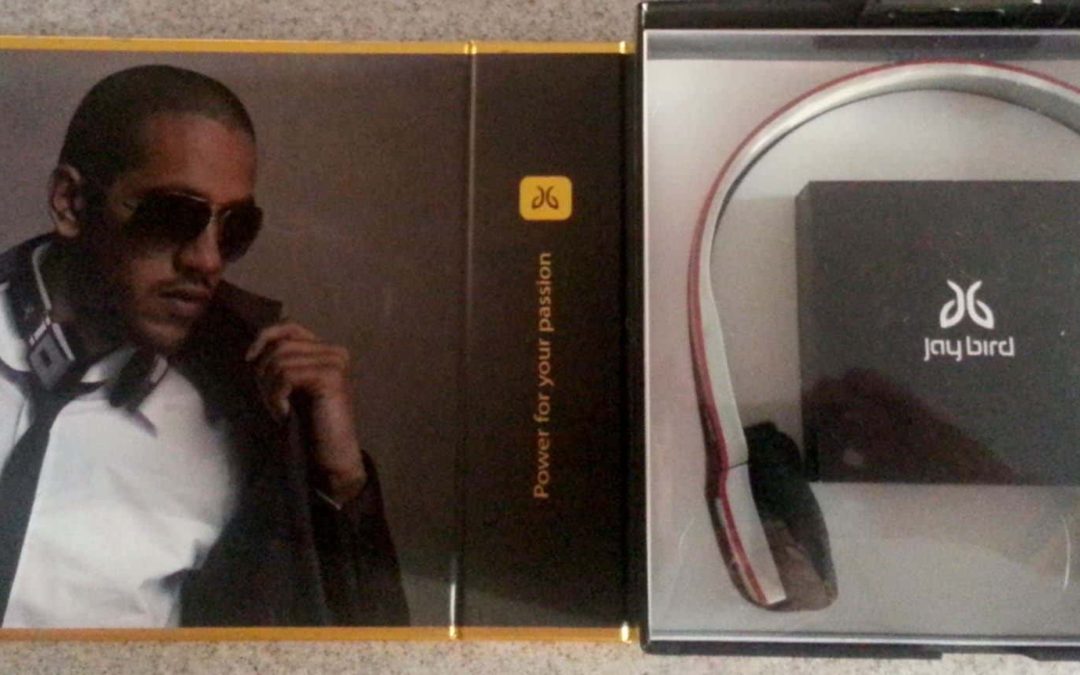
When I am not running in a group, or during a race when I know the course is not the most scenic, I do enjoy running with my iPod. There is something pretty cool about zoning out and just letting the beat take over my feet.
The problem I face, is comfort in headphones. I have tried just about every headphone out there and my personal preference is not ear buds that are placed inside he canal. I keep going back to the earphones I received with my iPod, that just fit above the lobe where the speaker sits on the concha and faces the canal. Of course, they do not last, and the sound quality has a little to be desired. Not to mention, the inconvenience of those wires.
Enter Jaybird with their Sportsband Bluetooth Headset. Jaybird was nice enough to send me this model, which looks like the older headphones that fit over the head instead of around the back of the neck or just sitting in the ear. They are extremely light, which does not cause any neck pain or strain and due to the fact they are Bluetooth they are wireless. I ran the entire Sarasota Half Marathon without them sliding off my ears, or hear any hesitation or disconnect from my iPod.
The controls are located on the right ear and have nice size buttons that are easy to access and allow you to skip forward or back, pause and control the volume.
The sound quality is probably the best I have heard in a Bluetooth headset. The sound is rich, clear and responds well to the sound controls on my iPod. Needless to say I really enjoyed wearing this headset during the race. 
As, I was looking at the pics…well…the profile is pretty low, but they do look kinda goofy if your looking for them. It figures, look who is wearing them.
I did test them with two different phones as well. The Droid Razor Maxx and the Samsung Galaxy Note II and they responded quick and as expected to Pandora, Spotify, the built-in music apps and the phone.
A friend of mine, that didn’t know she was a part of this review, stated she thought I was using my handset. Most of the time she could tell, when I had a headset on, because the sound quality was usually pretty poor, but with the Jaybird Sportsband this was not the case at all. The sound was clear without static or hesitation.
The Jaybird Sportsband comes in two models, the original the S2 which includes the uSport universal Bluetooth adapter. Both models are compatible with any A2DP Bluetooth device to include iPhone, iPad, iPod(7th Gen), Android, windows devices, PC and Mac. Options include the iSport and universal Bluetooth adapters on the original and S2 models.
The company just so happened to send me apple red, but there are also a wide range of colors available.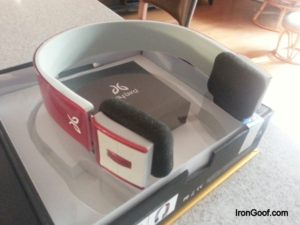
I really enjoy running with this headset. It fits over my ear and not inside, which is more comfortable for and it still allows me to hear ambient noise around me which makes my music motivating not distracting.
I give this device 5 out of 5 Goofs.